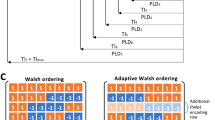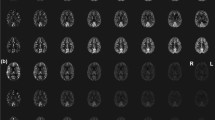Abstract
Object
While pseudo-continuous arterial spin labeling (pCASL) is a promising imaging technique to visualize cerebral blood flow, it is also (acoustically) very loud during labeling. In this paper, we reduced the labeling loudness on our scanner by increasing the interval between the RF pulses from the literature standard of 1.0 ms. We also propose recommendations to reduce the loudness on scanners of the same type at other sites.
Materials and methods
First, the sound pressure level (SPL) was both simulated and measured as a function of the labeling interval (1.0–1.8 ms) and longitudinal position in the scanner (−10 to +10 cm, relative to isocenter). Subsequently, we selected the labeling interval with the lowest overall SPL for the "SPL-optimized" pCASL sequence. Nine volunteers were scanned to compare raw signal intensity, temporal signal-to-noise ratio (tSNR) and labeling efficiency between the SPL-optimized and the standard PCASL sequence.
Results
Sound pressure level measurements on our scanner showed that loudness was reduced by 6.5 dB at the approximate location of the ear by adjusting the labeling interval to 1.4 ms. Furthermore, image quality was not affected, since no significant differences in signal intensity, tSNR and labeling efficiency were observed.
Conclusion
By increasing the pCASL labeling interval, acoustic noise in the pCASL sequence was reduced with 6.5 dB, while image quality was preserved.




Similar content being viewed by others
References
Detre JA, Rao H, Wang DJ, Chen YF, Wang Z (2012) Applications of arterial spin labeled MRI in the brain. J Magn Reson Imaging 35(5):1026–1037
Dai W, Garcia D, de Bazelaire C, Alsop DC (2008) Continuous flow-driven inversion for arterial spin labeling using pulsed radio frequency and gradient fields. Magn Reson Med 60(6):1488–1497
Haller S, Bartsch AJ, Radue EW, Klarhöfer M, Seifritz E, Scheffler K (2005) Effect of fMRI acoustic noise on non-auditory working memory task: comparison between continuous and pulsed sound emitting EPI. Magn Reson Mater Phy 18(5):263–271
Schmitter S, Diesch E, Amann M, Kroll A, Moayer M, Schad LR (2008) Silent echo-planar imaging for auditory FMRI. Magn Reson Mater Phy 21(5):317–325
ISO 1999:1990 Legal ruling issued by the International Organization for Standardisation (ISO). Acoustics—determination of occupational noise exposure and estimation of noise-induced hearing impairment
Welleschik B (1979) The effect of the noise level on the occupational hearing loss. Observations carried cut in 25,544 industrial workers (translated from German). Laryngol Rhinol Otol (Stuttg) 58(11):832–841
Seifritz E, Di Salle F, Esposito F, Herdener M, Neuhoff JG, Scheffler K (2006) Enhancing BOLD response in the auditory system by neurophysiologically tuned fMRI sequence. Neuroimage 29(3):1013–1022
Peelle JE, Eason RJ, Schmitter S, Schwarzbauer C, Davis MH (2010) Evaluating an acoustically quiet EPI sequence for use in fMRI studies of speech and auditory processing. Neuroimage 52(4):1410–1419
Hennel F, Girard F, Loenneker T (1999) “Silent” MRI with soft gradient pulses. Magn Reson Med 42(1):6–10
Hedeen RA, Edelstein WA (1997) Characterization and prediction of gradient acoustic noise in MR imagers. Magn Reson Med 37(1):7–10
Geddes GKE (1968) The assessment of noise in audio-frequency circuits. BBC research division Report. EL-17 UDC 534.586
Aslan S, Xu F, Wang PL et al (2010) Estimation of labeling efficiency in pseudocontinuous arterial spin labeling. Magn Reson Med 63(3):765–771
Yushkevich PA, Piven J, Hazlett HC et al (2006) User-guided 3D active contour segmentation of anatomical structures: significantly improved efficiency and reliability. Neuroimage 31(3):1116–1128
Wang J, Alsop DC, Li L et al (2002) Comparison of quantitative perfusion imaging using arterial spin labeling at 1.5 and 4.0 Tesla. Magn Reson Med 48(2):242–254
Lu H, Nagae-Poetscher LM, Golay X, Lin D, Pomper M, van Zijl PCM (2005) Routine clinical brain MRI sequences for use at 3.0 Tesla. J Magn Reson Imaging 22(1):13–22
Teeuwisse WM, Nederveen AJ, Ghariq E, Heijtel DF, van Osch MJ (2011) Comparison of spin dynamics in pseudo-continuous and velocity-selective arterial spin labeling with and without vascular crushing. In: Proceedings of the 19th scientific meeting, International Society for Magnetic Resonance in Medicine, Montreal, p 2115
Lu H, Clingman C, Golay X, van Zijl PCM (2004) Determining the longitudinal relaxation time (T1) of blood at 3.0 Tesla. Magn Reson Med 52(3):679–682
Herscovitch P, Raichle ME (1985) What is the correct value for the brain-blood partition coefficient for water? J Cereb Blood Flow Metab 5(1):65–69
Chalela JA, Alsop DC, Gonzalez-Atavales JB, Maldjian JA, Kasner SE, Detre JA (2000) Magnetic resonance perfusion imaging in acute ischemic stroke using continuous arterial spin labeling. Stroke 31(3):680–687
Garcia DM, Duhamel G, Alsop DC (2005) Efficiency of inversion pulses for background suppressed arterial spin labeling. Magn Reson Med 54(2):366–372
Chen Y, Wang DJJ, Detre JA (2012) Comparison of arterial transit times estimated using arterial spin labeling. Magn Reson Mater Phy 25(2):135–144
Vidorreta M, Wang Z, Rodriguez I, Pastor MA, Detre JA, Fernandez-Seara MA (2013) Comparison of 2D and 3D single-shot ASL perfusion fMRI sequences. Neuroimage 66:662–671
Wu Z, Kim YC, Khoo MCK, Nayak KS (2013) Evaluation of an independent linear model for acoustic noise on a conventional MRI scanner and implications for acoustic noise reduction [published online ahead of print]. Magn Reson Med. doi:10.1002/mrm.24798
Acknowledgments
This work was supported by Grant 0903-044 from the Nuts-Ohra foundation (Amsterdam, Netherlands) and by VICI Grant 453.07.001 from the Netherlands Organization for Scientific Research Cognition (NWO, the Hague, Netherlands).
Author information
Authors and Affiliations
Corresponding author
Additional information
Johan N. van der Meer and Dennis F. R. Heijtel have contributed equally to this work.
Rights and permissions
About this article
Cite this article
van der Meer, J.N., Heijtel, D.F.R., van Hest, G. et al. Acoustic noise reduction in pseudo-continuous arterial spin labeling (pCASL). Magn Reson Mater Phy 27, 269–276 (2014). https://doi.org/10.1007/s10334-013-0406-3
Received:
Revised:
Accepted:
Published:
Issue Date:
DOI: https://doi.org/10.1007/s10334-013-0406-3




